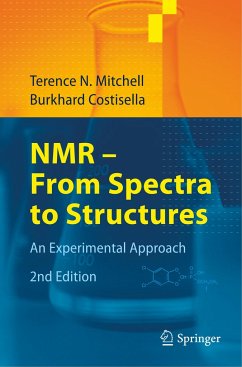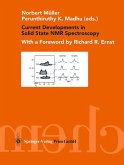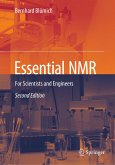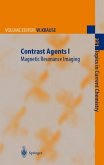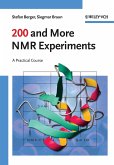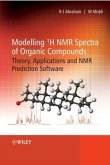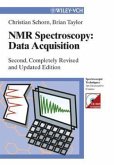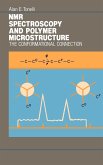Nuclear magnetic resonance spectroscopy is one of the most powerful analytical methods. This practice-oriented textbook aims at teaching how NMR experiments should be used to make structural asssignments. The book is intended as a practical guide for students and laboratory personnel, so that the emphasis is on practical rather than on theoretical aspects, which are treated only to the extent necessary to understand the experiments and to interpret the results.
The second edition has been expanded to include several other heteronuclei (15N, 19F, 29Si, 77Se, 113Cd, 117Sn/119Sn, 195Pt, 207Pb) and a new chapter on solid state NMR. The problems section has been enlarged and now includes 50 problems. These are of different degrees of complexity and in all cases include two-dimensional (2D) methods as well as standard proton and carbon 1D spectra.
The second edition has been expanded to include several other heteronuclei (15N, 19F, 29Si, 77Se, 113Cd, 117Sn/119Sn, 195Pt, 207Pb) and a new chapter on solid state NMR. The problems section has been enlarged and now includes 50 problems. These are of different degrees of complexity and in all cases include two-dimensional (2D) methods as well as standard proton and carbon 1D spectra.
From the reviews:
"This practice-oriented textbook aims at teaching the use of NMR spectra in the elucidation of organic structures. The emphasis of the book is on practical rather than on theoritical (sic) aspects ... is intended as a practical guide to today's standard NMR experiments for students and laboratory personnel. The set of 35 graded problems includes not only ... for the first time in a textbook, also the most important 2D spectra (H, H and C,H correlation)." chemie Nouvelle Societe Royale de Chemie, Vol. 22(87), 2004)
"The topic of this book is NMR spectroscopy on a basic level with the aim of spectral interpretation for structural elucidation. ... The basic features of NMR are explained with the help of ... . This book can be recommended for students ... provides excellent training for the brain-based structure generator and stimulates learning of how to correlate spectral evidence with structural properties. ... and offers many interesting spectral problems for self-assessment." (Stefan Berger, Anal Bioanal Chem, Vol. 381, 2005)
"This book aims to teach the skill of solving the structure of organic compounds from their NMR spectra. ... The description of NMR experiments is refreshingly clear, written for readers who have ... . The authors also include some useful experimental tips on how to record spectra ... . eminently suitable for any synthetic chemist doing a research degree. The book could also form the basis of an excellent advanced level undergraduate course ... ." (Chemistry World, November, 2004)
"In NMR - From Spectra to Structures ... have set out to provide a practical course in structure determination by NMR spectroscopy with only the essential minimum of theoretical "ballast". The first part consists of 50 pages describing methods ... with brief guidance on how to assign and interpret the spectral features. The style makes for easy reading almost throughout, withcarefully edited spectra and clear formulas ... is very good." (Nils Schlörer, Angewandte Chemie, Vol. 43(40), 2004)
"This little book is aimed at students and staff who have had little experience with NMR and need to start using it for organic structural elucidation. ... In the first half, the authors ... concentrate on providing a brief introduction to the different types of basic ... . The second half of the book begins with a short ... . I would recommend this book to students and staff who have had minimal undergraduate exposure to NMR but who need to start making ... ." (Julie Niere, Chemistry in Australian Magazin of the Royal Australian Chemical Institute, July, 2004)
"The book is intended to be a practical guide ... . A set of thirty-five graded problems reinforces the reader's understanding of how problems of structure elucidation are solved by using NMR techniques. ... This practical and comprehensed NMR handbook can be warmly recommended to graduate and undergraduate students in chemistry, biochemistry, and pharmacology, but also to experienced personnel in analytical laboratories for structure determination and elucidation." (Advances in Food Sciences, Vol. 26(2), 2004)
From the reviews of the second edition:
"Mitchell and Costisella ... examine modern nuclear magnetic resonance (NMR) spectroscopy using purely practical aspects and applications. They look at the uses of NMR without becoming bogged down with all of the theory and mathematics behind the experiment. ... both one- and two-dimensional techniques are explained. ... A must read for both undergraduate and graduate students who use NMR as an analytical tool. Summing Up: Highly recommended. Lower- and upper-division undergraduates; graduate students; two-year technical program students." (S. S. Mason, CHOICE, Vol. 45 (8), 2008)
"This practice-oriented textbook aims at teaching the use of NMR spectra in the elucidation of organic structures. The emphasis of the book is on practical rather than on theoritical (sic) aspects ... is intended as a practical guide to today's standard NMR experiments for students and laboratory personnel. The set of 35 graded problems includes not only ... for the first time in a textbook, also the most important 2D spectra (H, H and C,H correlation)." chemie Nouvelle Societe Royale de Chemie, Vol. 22(87), 2004)
"The topic of this book is NMR spectroscopy on a basic level with the aim of spectral interpretation for structural elucidation. ... The basic features of NMR are explained with the help of ... . This book can be recommended for students ... provides excellent training for the brain-based structure generator and stimulates learning of how to correlate spectral evidence with structural properties. ... and offers many interesting spectral problems for self-assessment." (Stefan Berger, Anal Bioanal Chem, Vol. 381, 2005)
"This book aims to teach the skill of solving the structure of organic compounds from their NMR spectra. ... The description of NMR experiments is refreshingly clear, written for readers who have ... . The authors also include some useful experimental tips on how to record spectra ... . eminently suitable for any synthetic chemist doing a research degree. The book could also form the basis of an excellent advanced level undergraduate course ... ." (Chemistry World, November, 2004)
"In NMR - From Spectra to Structures ... have set out to provide a practical course in structure determination by NMR spectroscopy with only the essential minimum of theoretical "ballast". The first part consists of 50 pages describing methods ... with brief guidance on how to assign and interpret the spectral features. The style makes for easy reading almost throughout, withcarefully edited spectra and clear formulas ... is very good." (Nils Schlörer, Angewandte Chemie, Vol. 43(40), 2004)
"This little book is aimed at students and staff who have had little experience with NMR and need to start using it for organic structural elucidation. ... In the first half, the authors ... concentrate on providing a brief introduction to the different types of basic ... . The second half of the book begins with a short ... . I would recommend this book to students and staff who have had minimal undergraduate exposure to NMR but who need to start making ... ." (Julie Niere, Chemistry in Australian Magazin of the Royal Australian Chemical Institute, July, 2004)
"The book is intended to be a practical guide ... . A set of thirty-five graded problems reinforces the reader's understanding of how problems of structure elucidation are solved by using NMR techniques. ... This practical and comprehensed NMR handbook can be warmly recommended to graduate and undergraduate students in chemistry, biochemistry, and pharmacology, but also to experienced personnel in analytical laboratories for structure determination and elucidation." (Advances in Food Sciences, Vol. 26(2), 2004)
From the reviews of the second edition:
"Mitchell and Costisella ... examine modern nuclear magnetic resonance (NMR) spectroscopy using purely practical aspects and applications. They look at the uses of NMR without becoming bogged down with all of the theory and mathematics behind the experiment. ... both one- and two-dimensional techniques are explained. ... A must read for both undergraduate and graduate students who use NMR as an analytical tool. Summing Up: Highly recommended. Lower- and upper-division undergraduates; graduate students; two-year technical program students." (S. S. Mason, CHOICE, Vol. 45 (8), 2008)

